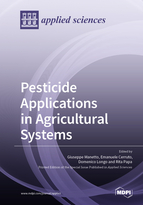Pesticide Applications in Agricultural Systems
A special issue of Applied Sciences (ISSN 2076-3417). This special issue belongs to the section "Environmental Sciences".
Deadline for manuscript submissions: closed (31 December 2020) | Viewed by 17810
Special Issue Editors
Interests: agricultural machines; pesticide applications (nozzle, sprayers, distribution uniformity, spray drift, worker exposure); mechanical distribution of natural enemies; safety in agriculture (noise and vibrations both in field and food-industry plants); post-harvest (packing lines, mechanical fruit damage); sustainable agriculture (anaerobic digestion plants, biomasses, digestate spreading, erosion, sod-seeding)
Special Issues, Collections and Topics in MDPI journals
Interests: pesticide application (foliar deposition, ground losses, worker exposure, spray quality); post-harvest (packing lines, mechanical fruit damage); worker safety (noise and vibration exposure); renewable energies (anaerobic digestion plants, digestate spreading)
Special Issues, Collections and Topics in MDPI journals
Interests: robotics; agricultural machines; precision agriculture; automatic control systems; electronics and sensors; biosensors; measurement system; informatics
Special Issues, Collections and Topics in MDPI journals
Interests: pesticide application (foliar deposition, spray quality); integrated/organic pest control (mechanical distribution of natural enemies); worker safety (noise and vibration exposure); renewable energies (anaerobic digestion plants, digestate spreading)
Special Issues, Collections and Topics in MDPI journals
Special Issue Information
Dear Colleagues,
We are organizing a Special Issue on “Pesticide Applications in Agricultural Systems” in Applied Sciences (MDPI).
Spraying plant protection products (PPP) is recognized, also at the regulatory level, as one of the agricultural activities that have the most impact on human health and the environment. The effects of PPP on human health involve operators, farmworkers and bystanders, consumers, professionals, and the general population, whereas those on the environment involve water, soil and atmosphere quality, and non-target organisms such as vertebrates, useful arthropods, and other invertebrates. Therefore, on the one hand, researchers and manufacturers are trying to make the application of PPP more sustainable according to precision agriculture principles and, on the other, to promote non-chemical approaches.
Worker exposure, environmental effects, deposition on the target, and efficacy of pesticide applications are affected by numerous variables, including active substance, adjuvants and formulation, type of equipment used and its status, nozzle and droplet size spectrum, target features and canopy structure, amount of pesticide handled and the packaging, environmental conditions, duration of the activity, personal protective equipment (PPE) used, worker capability, and others.
The equipment status, its drift potential, its inspection according to the legal framework, and the user knowledge, are all prerequisites for a successful application. Sprayer calibration by means of suitable test benches according to the crop features or according to real-time data (precision spraying) is another key point to minimize the environmental impact of pesticides. Finally, waste management after treatment is crucial when environmental effects are examined.
The topics of interest for this Special Issue include, but are not limited to, the following (in alphabetical order):
- Deposit assessment and dose adjustment
- Measurement equipment
- Modeling of spray and airflow pattern
- Operator safety and risk mitigation
- Remote sensing for precision pest management
- Spray drift reducing technologies
- Spray quality assessment
- Sprayer inspection
- Spraying equipment
- Waste management and environment safeguard
Dr. Giuseppe Manetto
Prof. Dr. Emanuele Cerruto
Dr. Domenico Longo
Dr. Rita Papa
Guest Editors
Manuscript Submission Information
Manuscripts should be submitted online at www.mdpi.com by registering and logging in to this website. Once you are registered, click here to go to the submission form. Manuscripts can be submitted until the deadline. All submissions that pass pre-check are peer-reviewed. Accepted papers will be published continuously in the journal (as soon as accepted) and will be listed together on the special issue website. Research articles, review articles as well as short communications are invited. For planned papers, a title and short abstract (about 100 words) can be sent to the Editorial Office for announcement on this website.
Submitted manuscripts should not have been published previously, nor be under consideration for publication elsewhere (except conference proceedings papers). All manuscripts are thoroughly refereed through a single-blind peer-review process. A guide for authors and other relevant information for submission of manuscripts is available on the Instructions for Authors page. Applied Sciences is an international peer-reviewed open access semimonthly journal published by MDPI.
Please visit the Instructions for Authors page before submitting a manuscript. The Article Processing Charge (APC) for publication in this open access journal is 2400 CHF (Swiss Francs). Submitted papers should be well formatted and use good English. Authors may use MDPI's English editing service prior to publication or during author revisions.
Keywords
- Airflow rate
- Crop protection
- Deposit
- Dose
- Droplet size
- Measurement equipment
- Modeling
- Nozzle inspection
- Nozzle testing
- Operator exposure
- Pesticide
- Pesticide application equipment
- Pollution from point sources
- Precision spraying
- Risk mitigation
- Safety
- Spray drift
- Spray quality
- Sprayer calibration
- Sprayer inspection
- Spraying equipment
- Waste management
- Water sensitive papers









